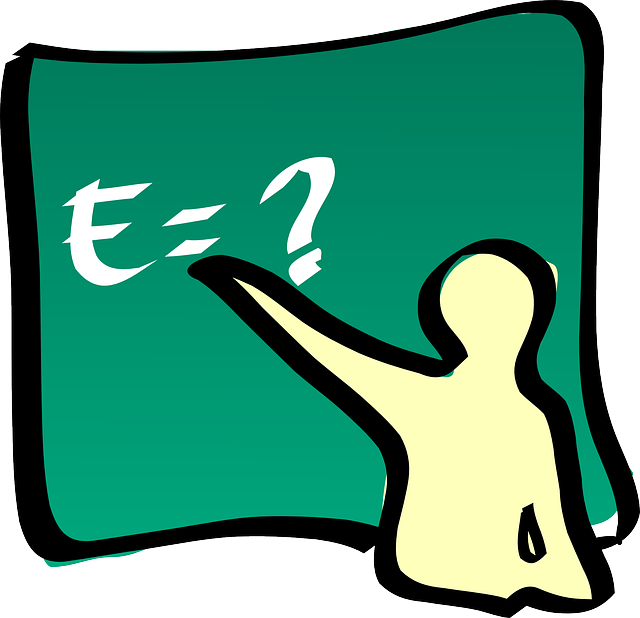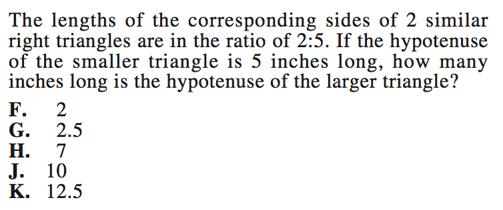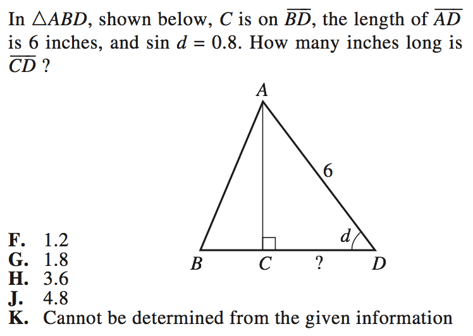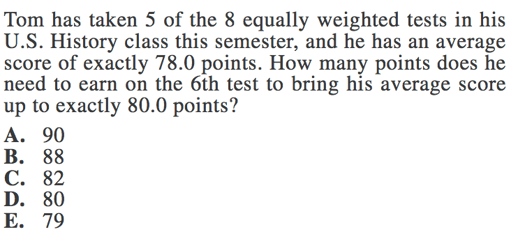
The ACT allows for guessing without penalty (no negative points here!), but how can you turn guessing into the best strategy to maximize your ACT math score? The more you can increase your guessing odds, the better off you’ll be. And we’re here to show you how.
We’ll go through when and how to guess strategically on the ACT math section as well as show you examples of how to guess most effectively in action.
Refresher on ACT Math Scoring
The ACT is a standardized test and is issued multiple times per year to hundreds of thousands of students, all of whom are scored on the same grading structure. What this means is that each ACT must look and feel like every other ACT as much as possible so that the scoring system is evenly balanced. The individual questions may vary, but the patterns in how the test-makers design both the questions and the answer choices will be as similar as possible.
With time and practice, you can learn to not only recognize the structural patterns of the ACT math section when you see them, but also use the clues in both the question and the answer choices to help you find the right answer (or at least narrow down your options!). After all, why take a 20% shot of guessing the right answer when you can bump those odds up to 33% or even 50%?
In terms of structure, the ACT math section is 60 math questions in 60 minutes. Each and every question will be a multiple choice question with 5 answer choices. Because the test is presented as multiple choice, the right answer will always be there amongst the answer choices, while incorrect answers are usually generated by common student errors.
As for how the test is scored, for each multiple choice question, you will get: +1 point for every correct answer and 0 points for every incorrect or blank answer. There is no negative penalty for an incorrect answer.
Developing a Target Score
Though you will not be penalized for answering a question incorrectly, your overall test-taking strategy is still going to be tremendously influenced by your target score. And these strategies will change as your score goals change.
Why does your target score matter if you aren’t penalized for wrong answers? The ACT math section puts the pressure on by putting you on a strict time crunch, which means that many students cannot take as much time per question as they would like to. You may find you cannot even finish the whole test in the time allotted, or that you couldn’t take the time to be as careful on each problem as you had hoped. Because of this, you will have to develop a plan of attack in terms of questions you can answer thoroughly and questions you have to take a guess on.
But before you develop your attack plan, you must first figure out your baseline. Take a practice test and come up with different ways to mark your questions--one mark for questions you don't know how to do, and another mark for questions you're only somewhat confident about. You may even want to create a third marker for questions that you know how to do, but will take a long time or will require multiple steps, so must be done carefully to avoid error. This way, you can save them for last (though this is optional).
For now, use your best judgment on how to guess the questions you've marked, but do make sure that you can identify which problems were which later. These marks will help you when you go to analyze your answers (and your guessing strategy) in the next section.
Lastly, once you're done with the test, check out our guide to developing your ideal target score, based on your current score and your future goals.

Guessing Based on Target Score
After you find your target curved score, see how that translates to your raw score. How many questions must you answer correctly to get that target score? Keep that number in your head and then focus the majority of your attention on a few more questions than that target. Why? You're leaving yourself room to get a few questions wrong.
So if you need a raw score of 40 to reach your goal, focus the majority of your attention on the first 45-48 questions. The questions are grouped in order of ascending difficulty, so your best bet is to concentrate your hardest on this area.
Do note that you should answer each and every question on the ACT math section, even if you have to make a random guess. The reason we said that you should “focus the majority of your attention” on the questions in your target range is because your time and your focus are precious commodities on the ACT. You’re trying to get as many points possible across the board, so your maximum focus should be on your target score range.
Once you’ve dedicated your time to the first 35, 40, or 50 questions (whatever your score range may be), you can feel free to guess on the rest of your questions without fear of reprisal. The odds are that you’ll get a few of them right and there are absolutely no consequences. (For more on this, check out our guide on how to stop running out of time on the ACT math section.)
So when should you guess and when should you try to answer the problem? Even if a question is in your prime scoring range, the time to guess is when:
-
You have absolutely no idea how to solve the problem
-
You think the question will take too long to go through properly (make a guess now and come back to it later if you have time)
-
You’re running out of time and need to answer several more questions
-
You’re in your “bonus scoring” zone (aka, not your prime scoring range)
Again, remember to mark these different question types. Once you’ve scored your test, look back on the questions you marked. How accurate is your guessing right now? Is there a pattern in your missed guesses?
Odds are that you've gotten some of the questions right that you guessed on, but we're looking to increase that accuracy as much as possible. So let’s talk about the most effective guessing strategies for ACT math.

Think of your test-taking like a science experiment--you will have your own unique score goals and ways of thinking. As you get more used to working with ACT questions, you'll get better at refining the methods that work best for your unique skill set.
ACT Math Guessing Strategies
The ACT math section is designed to test how well you’ve learned your math topics and principles and whether you can recognize and figure out how to apply these mathematical concepts to new situations. Most ACT math questions will be fairly straightforward (meaning they are not designed to trick you, even if they are difficult), and each and every math topic on the test is one that you are likely familiar with and have studied for a number of years.
This is all to say that you likely have a better understanding of the questions than you may think, even if you don’t know how to actually solve the problem. Often (though not always), a little strategy will allow you to eliminate at least one or two answer choices and make an educated guess.
Note: this may seem obvious, but only use your guessing strategies when you don't know how to solve a problem or are not confident about your answer. Guessing often takes a little more time than a straight-solve, so if you know the answer, great! Move on to the next problem. Only stop and take the time to guess if you're stuck.
We’ve laid out three of the most important rules of thumb that go into making an educated guess on an ACT math problem. Most of the time you will use a combination of these three techniques on any given problem, so they are less individual strategy than they are a combination of thought processes that you should go through every time you make a guess.
So let’s look at all three techniques needed to best make guesses (and when to do so!) on the ACT math section.
Guessing Strategy 1: Process of Elimination
Being able to eliminate answers on ACT questions is arguably a more important skill than even being able to solve questions (or at least equally as important). The entire ACT math section is multiple choice, which is great news for guessing. For every multiple choice question, the right answer is there somewhere. The more you can narrow down your options, the better off you’ll be when you go to make your selection. You don’t even need to know the right answer so long as you know that four of the answers are wrong. If you can eliminate four wrong answers, whatever remains must be correct.
Do you know the answer must be a line that slopes up and to the right, even if you don't know where it's supposed to be positioned horizontally? Do you know that the answer must be negative? Even knowing just a tiny bit about the problem or its possible answer will often be enough to eliminate a few answer options.
But what if can't eliminate four answer choices and find the final, correct answer? Not to worry! Even if you can only eliminate one answer choice, you’re still better off doing so than taking a shot completely in the dark. Let’s break it down.
Eliminating 0 Answer Choices
So you’ve come to a question and you can’t eliminate any answer choices at all--should you still guess? Always!
There are two scenarios for when you can’t eliminate any answer choices--questions you’ve looked at but don’t know how to solve, and questions that you haven’t even gotten a chance to look at. For the second scenario, imagine that you’ve just answered question 45 and you’ve got one minute left on the clock. You have no time to even look at the next 15 questions, so you’ve got to just fill in your bubbles and hope that the odds will be in your favor.
But no matter what the scenario, if you truly cannot eliminate any answer choice, your best plan of attack will be the same. DON’T pick the most “tempting” answer or an answer at “random.” Instead, when guessing without elimination, choose your favorite letter--A, B, C, D, or E--and always choose the same letter every time you have to make a blind guess. (Note: A is the same as F, B is the same as G, etc.)
Wait, what?
There are always five answer options for any given multiple choice question, so the odds of choosing the right answer at random is one-in-five, or 20%. But the catch is that human beings are NOT random. No matter how we try, our attempts at creating randomness will inevitably fail. If you try to make your best attempt at “randomness,” and guess wildly across the board, you’re more likely to get less than 20% of your guesses right. The best way to achieve randomness is to go in the complete opposite direction--pick one letter and stick with it every time.
When in doubt, pick your same favorite letter for every question you have to answer blindly, and move on.
Eliminating 1 Answer Choice
All right, but let’s say you can eliminate one answer choice. How should you guess now?
Again, you will always have five total answer options for each question. Now, with one option removed, the odds of us guessing the right answer will be one-in-four, or 25%.
And yet, this is still a time to stick with your “favorite letter” strategy. There are still too many options at play to start jumping around in your guessing strategy, so your best bet is to stick with your previous strategy and guess your same, favorite letter. Unless your designated letter is the answer choice that has been eliminated (in which case, go ahead and pick a backup letter), your best shot of succeeding at the random odds are to guess your same consistent answer choice.
Eliminating 2 Answer Choices (Now We’re Getting Somewhere!)
You’ve eliminated two answer choices that you know have to be wrong and are down to three possibilities. This is the time to change up your guessing strategy.
If you can eliminate two answer choices, the odds are that you know at least a little bit about this kind of math problem. Maybe you’ve only got enough knowledge about exponents to know that the answer can’t possibly be negative, or enough of an understanding of probabilities and fractions to know that the denominator must be even.
If you’re familiar enough with the type of math problem that you can eliminate two answer choices, you’re likely to be familiar enough with the problem to make your best guess. A random shot at the answer will get you a one-in-three chance of getting it right, or 33%, and your best guess should put you at those same odds, if not a little higher.
But the best way to test your mathematical instincts on problems like these is to look back through your practice test. For any questions where you were down to three, how many times did you guess the correct answer? How many times did you get it wrong? Take a look at your previous patterns. If your odds were less than 33%, it might be time to go back to your “favorite letter” strategy.
Eliminating 3 Answer Choices
If you can eliminate three answer choices, you’re in a great place! This will give you a one-in-two shot of choosing the correct answer, or 50%.
Go with your gut, do eenie-meenie-miny-mo, or choose the letter you like best. And again, look over your previous guesses of this nature. How often were you right or wrong? Did you guess at 50% odds every time you were able to eliminate three answer choices?
Your strategies for guessing and elimination should always be informed by your past performance. When something is working, refine it as best you can. When something isn’t working, alter your approach.
Eliminating 4 Answer Choices
If you can confidently eliminate four answer options, then celebrate! No need for guessing here--you’ve found the correct answer.
We’ve talked about guessing after you’ve eliminated answers, but how exactly do you go about eliminating answer choices? Let’s take a look.

Guessing Strategy 2: Approximating
If you have even a general idea of what the right answer might be (even a ballpark figure will do), you will often be able to eliminate one or two of the most blatant outliers. Though the answer choices are most often generated based on common student errors, there will still generally be answer choices that are way far afield.
Do you know that the answer must be positive? Discard anything negative right away. If you’re given the hypotenuse of a triangle, you know that each leg must be less than that given hypotenuse. Discard anything equal to or greater than the hypotenuse.
Let’s take a look at this in action. Don’t worry about actually solving the problem, just give yourself enough of a ballpark to see if you can eliminate one or two (or three or four!) answer choices.

Our two triangles are in a ratio of 2:5 for all their sides. Now we are looking to compare both their hypotenuses. The smaller triangle has a hypotenuse of 5, which means that the larger triangle must have a hypotenuse that is larger than 5. Already, we can eliminate answer choices F and G, since they are less than 5.
Now that leaves us with three answer choices, H, J, and K, which aren't bad odds for guessing, but we can go a little further than this. We know that the ratio is 2:5, which if we know anything about ratios, we know means that the larger side is a little more than double the smaller side. If the smaller hypotenuse is 5, the larger hypotenuse must be a little more than double this. This means that the hypotenuse of the larger triangle must be larger than 10.
The only answer choice that is larger than 10 is answer choice K, 12. 5. Though we haven't officially done the work to solve the problem, this is a very good guess, just based on approximation and process of elimination.
[Note: the correct answer is, indeed, K, 12.5.]
You can also approximate answers on geometric figures on the test. Although the instructions state that "illustrative figures are NOT necessarily drawn to scale," they essentially always are. (The exception is those in questions that ask about what MUST be true, i.e. what you can prove.) If you're attempting a question that asks about side lengths, angle measures, or ratios, you can use the figure to make a ballpark guess about these values.

This question is asking about specific values, so we can assume it's to scale. We can, therefore, make our guesses based on the given measurements.
In addition, as a general rule of thumb, the correct answer will be "cannot be determined" less than 20% of the time. So it's a good idea to eliminate this answer choice if you don't know how to solve this kind of problem. Always guess one of the values if you are forced to make a guess.
So, based on the given hypotenuse measure of 6, and the fact that our drawing is to scale, we can estimate that the measure of CD appears to be about half of that. This means that CD probably measures about 3. Maybe it's little more, maybe a little less, but we can most certainly eliminate answer choices F and G. And, since we already eliminated answer choice K, that leaves us with answer choices H and J. We've got a 50-50 chance, so it's a good time to make a guess. And an educated guess between the two choices would better favor answer choice H rather than answer choice J because it's close to our initial estimate of 3.
[Note: the correct answer is, indeed, H, 3.6.]
Guessing Strategy 3: Finding the Round Answers and Shortcuts
If we remember that the ACT math section is designed so that a student without a calculator can solve every problem, this can inform how we go about both solving our problems and eliminating our answer choices.
Not being able to use a calculator limits one’s mathematical possibilities, especially when a time-crunch is involved. For this reason, the ACT tends to favor shortcuts (like triangle shortcuts) and round numbers. If you can eliminate answer choices that would not produce nice, round numbers, you can often find your right answer.
Let’s look at this principle in action,

We are told that a bag originally contains 18 marbles, and we must find the additional number of marbles to get a 3/5 ratio. Well, a 3/5 ratio of marbles (an object that CANNOT be broken into pieces) means that our new total number of marbles must be divisible by 5 (since 5 is our denominator). This, in turn, means that our total number of marbles must have a units digit of either 0 or 5.
For 18 + x to equal a number ending in 0 or 5, x MUST end in either 2 or 7. (e.g., 18 + 2 = 20, or 18 + 17 = 35).
We can, therefore, eliminate every answer choice that does NOT end in 2 or 7. In this case, we can eliminate every answer choice except for F.
We didn’t even have to know how to solve the problem or walk through the steps. We just knew to look for a round and easy number to work with and found it through process of elimination.
[Note: the correct answer is, indeed, F, 12.]
Guessing Strategy 4: Avoiding Temptation
The test is designed around the statistically average student, and many of the answer choices are generated based on common student errors. Though the ACT is not designed to "trick" you, people have a tendency to fall into predictable thinking patterns, and it’s easy to select wrong answers that the average student falls for again and again if you’re not paying close attention.
If you look at a question in the medium or difficult range that you can solve in a second or two, it may just be too good to be true. If an answer choice seems immediately appealing, especially on a difficult question, it might just be a trap. Think about how many other students would have felt the same way on trial tests. Take a moment to really examine the question. Even if you don’t know how to solve it, you might still be able to spot a trap when you see it if you take a second to breathe.

Let’s say this is a problem that you have no idea how to go about solving, but you do know a little about averages. If you’re going quickly through the test or you are only thinking about the bare principles of averages, you might think that answer choice C looks awfully tempting.
After all, Tom’s starting with a score of 78 and he needs an 80. If he gets an 82, that seems like it will balance out about right...right?
Except that this question is number 47 out of 60, which means it is in the "medium-high difficulty" range. 82 is way too tempting of an answer to be correct for this level of difficulty. Even if we don’t know how to solve the question, we can pretty safely eliminate answer choice C.
Based off of our basic understanding of averages, we can also safely eliminate answer choices D and E. We might not know how to do weighted averages, but these answer choices seem way too small to raise up our current average of 78 to 80.
Without knowing how to solve the problem, we have narrowed down our options to answer choices A and B, which gives us a 50-50 chance of guessing correctly. Not bad at all!
[Note: the correct answer is A, 90.]

The Take-Aways
Though it is very useful to know how to actually solve your ACT math problems, we’ve seen that it is not always necessary. Though you shouldn’t guess on every ACT math question, it can help your scores to guess strategically when you have to do so.
Just remember to always use your guessing strategies when you have the chance to look at the problem, and stick with your favorite letter whenever you must make a blind guess. And take a deep breath. You probably know more than you think, and you probably know enough to at least eliminate an answer choice or two, even if you’re feeling overwhelmed. Practice and focus will have you beating the odds and boosting your scores in no time.
What’s Next?
Still not satisfied with your ACT math scores? Improve your individual ACT math topic skills by working through our individual math topic guides. In each guide, we will walk you through the definitions of each math topic, the formulas you'll need, and how you'll see the questions on the ACT math section. We'll also give you real ACT math problems (and answer explanations) for you to practice your skills on.
Been procrastinating on your ACT prep? If you've found yourself in a procrastination rut, check out our guide on how to stop procrastinating so you can get back to studying.
Aiming for a perfect score? If you're looking to score a perfect 36 on your ACT math section, then look no further than our guide to getting an 36 on the ACT math, written by a perfect-scorer.
Want to improve your ACT score by 4 points?
Check out our best-in-class online ACT prep program. We guarantee your money back if you don't improve your ACT score by 4 points or more.
Our program is entirely online, and it customizes what you study to your strengths and weaknesses. If you liked this Math lesson, you'll love our program. Along with more detailed lessons, you'll get thousands of practice problems organized by individual skills so you learn most effectively. We'll also give you a step-by-step program to follow so you'll never be confused about what to study next.
Check out our 5-day free trial:
Have friends who also need help with test prep? Share this article!

Courtney scored in the 99th percentile on the SAT in high school and went on to graduate from Stanford University with a degree in Cultural and Social Anthropology. She is passionate about bringing education and the tools to succeed to students from all backgrounds and walks of life, as she believes open education is one of the great societal equalizers. She has years of tutoring experience and writes creative works in her free time.


































 Holly R.
Holly R.